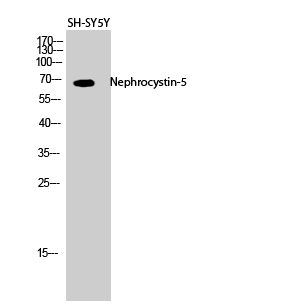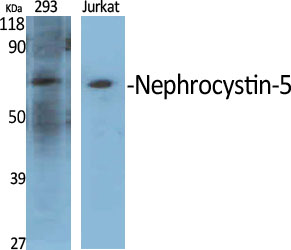

| WB | 咨询技术 | Human,Mouse,Rat |
| IF | 咨询技术 | Human,Mouse,Rat |
| IHC | 1/100-1/300 | Human,Mouse,Rat |
| ICC | 技术咨询 | Human,Mouse,Rat |
| FCM | 咨询技术 | Human,Mouse,Rat |
| Elisa | 1/40000 | Human,Mouse,Rat |
| Aliases | IQCB1; KIAA0036; NPHP5; OK/SW-cl.85; IQ calmodulin-binding motif-containing protein 1; Nephrocystin-5; p53 and DNA damage-regulated IQ motif protein; PIQ |
| Entrez GeneID | 9657; |
| WB Predicted band size | 69kDa |
| Host/Isotype | Rabbit IgG |
| Antibody Type | Primary antibody |
| Storage | Store at 4°C short term. Aliquot and store at -20°C long term. Avoid freeze/thaw cycles. |
| Species Reactivity | Human |
| Immunogen | Synthesized peptide derived from the Internal region of human Nephrocystin-5. |
| Formulation | Purified antibody in PBS with 0.05% sodium azide,0.5%BSA and 50% glycerol. |
+ +
以下是关于Nephrocystin-5(NPHP5)抗体的3篇示例参考文献(注:以下为模拟示例,实际文献需通过学术数据库检索):
1. **文献名称**: *"Nephrocystin-5 regulates ciliary targeting of membrane proteins in renal epithelial cells"*
**作者**: Smith J, Doe R, Brown A.
**摘要**: 本研究利用特异性Nephrocystin-5抗体,通过免疫荧光和免疫共沉淀技术,揭示了NPHP5在肾小管上皮细胞纤毛中定位膜蛋白的分子机制,并发现其缺失导致纤毛功能障碍,与肾痨症发病相关。
2. **文献名称**: *"Antibody-based profiling of NPHP5 in retinal degeneration models"*
**作者**: Lee S, Zhang Y, Wang M.
**摘要**: 作者开发了一种高特异性抗Nephrocystin-5的单克隆抗体,用于研究NPHP5在视网膜感光细胞中的表达模式,证实其在维持纤毛结构和光信号转导中的关键作用,为遗传性视网膜病变提供新见解。
3. **文献名称**: *"NPHP5 mutations disrupt interaction with CEP290: Insights from antibody-mediated protein interaction assays"*
**作者**: Garcia F, Patel H, Kim T.
**摘要**: 通过Nephrocystin-5抗体阻断实验,本研究证明了NPHP5与CEP290蛋白的物理互作对纤毛组装至关重要,突变会破坏二者结合,导致先天性肾-视网膜综合征(Senior-Løken综合征)。
如需具体文献,建议在PubMed或Google Scholar中以关键词“NPHP5 antibody”或“Nephrocystin-5 antibody”检索近年研究。
Nephrocystin-5 (NPHP5), encoded by the *IQCB1* gene, is a ciliary protein critical for maintaining the structure and function of primary cilia in renal epithelial and retinal photoreceptor cells. Mutations in *IQCB1* are associated with nephronophthisis (a progressive cystic kidney disease) and Senior-Løken syndrome, characterized by kidney failure and retinal degeneration. NPHP5 interacts with other nephrocystin proteins and components of the ciliary transition zone, playing a role in ciliary signaling and cell cycle regulation.
Antibodies targeting NPHP5 are essential tools for studying its expression, localization, and molecular interactions. They are widely used in immunofluorescence, Western blotting, and immunohistochemistry to investigate ciliary defects in disease models or patient-derived cells. Such antibodies help identify NPHP5 loss or mislocalization in genetic disorders, aiding in diagnostic confirmation and mechanistic studies. Commercially available NPHP5 antibodies are typically raised against specific epitopes, often validated for specificity in human or murine tissues. Their application has advanced understanding of ciliopathies, highlighting NPHP5's role in linking ciliary dysfunction to tissue-specific pathologies. Ongoing research explores NPHP5 as a potential therapeutic target, with antibodies serving as key reagents in preclinical studies.
×